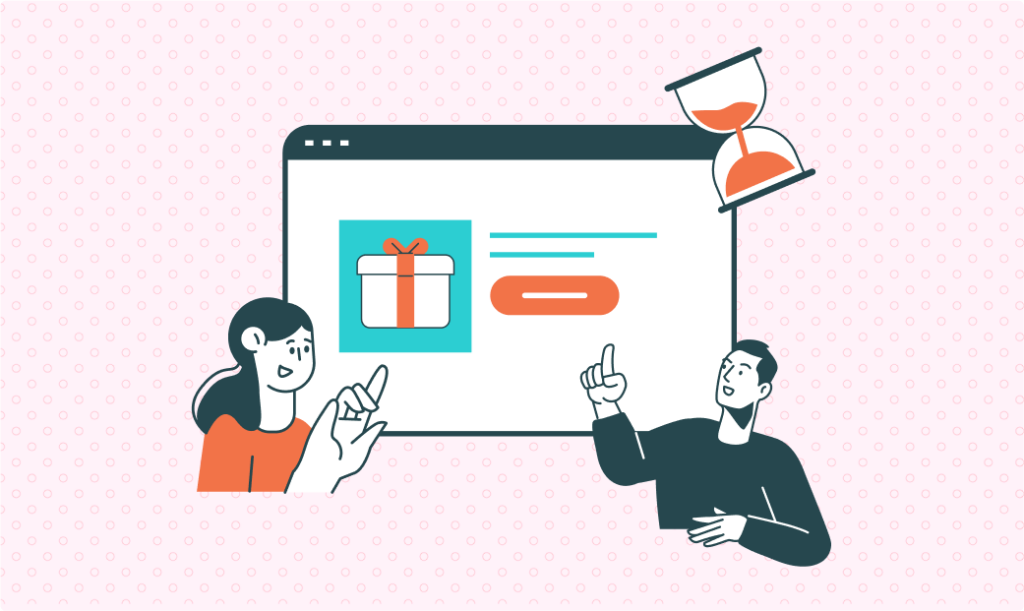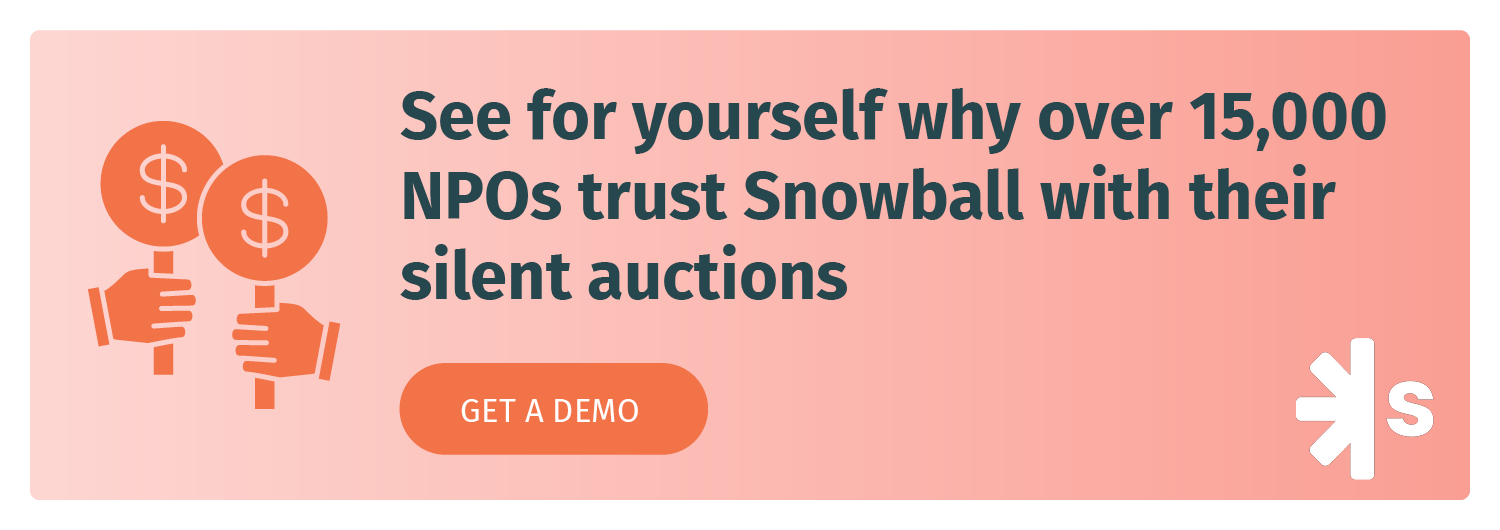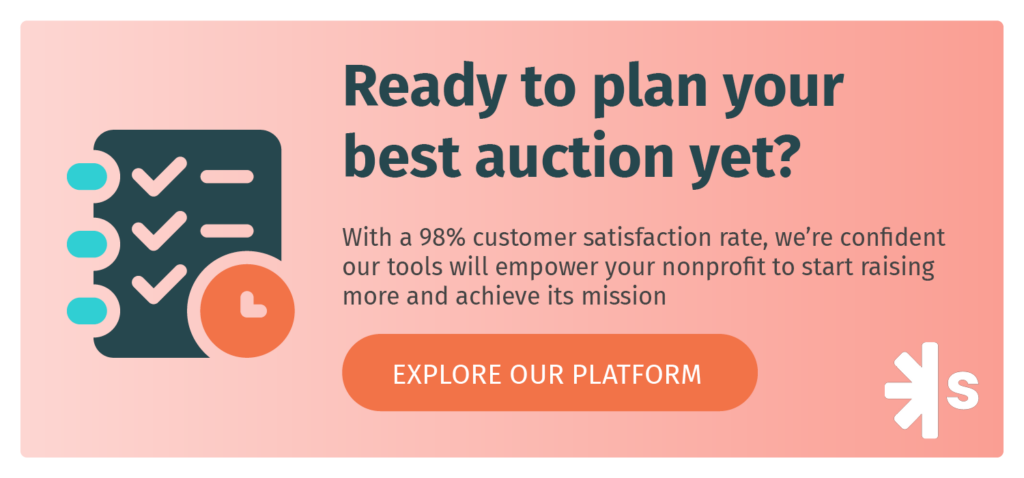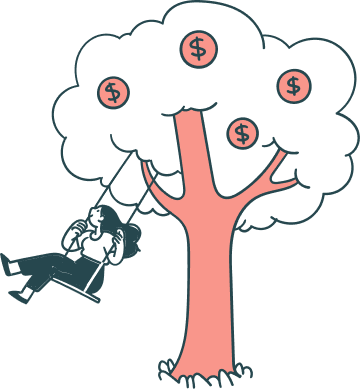As a fundraising professional, you likely know that effective charity auctions can raise awareness for your cause, boost supporter engagement, and help you solicit critical funding. But perhaps you’ve never hosted one yourself, or you’re looking for a refresher before planning your next big event.
That’s why we’ve put together this guide to pulling off a successful silent auction. We’ll cover the following topics to prepare you for hosting your own auction and bringing in the big bucks for your organization:
- Silent Auction FAQs
- How to Run a Silent Auction
- Best Practices for Silent Auctions
- Top Silent Auction Software
Ready to take your fundraising efforts to the next level with a silent auction? Let’s jump in!

Silent Auction FAQs
What Are Silent Auctions?
Silent auctions are a type of charity auction in which bidders can browse, bid on, and purchase items without the supervision of an auctioneer by placing their bid electronically or on a physical sheet of paper.
This format differs from live auctions in the following ways:
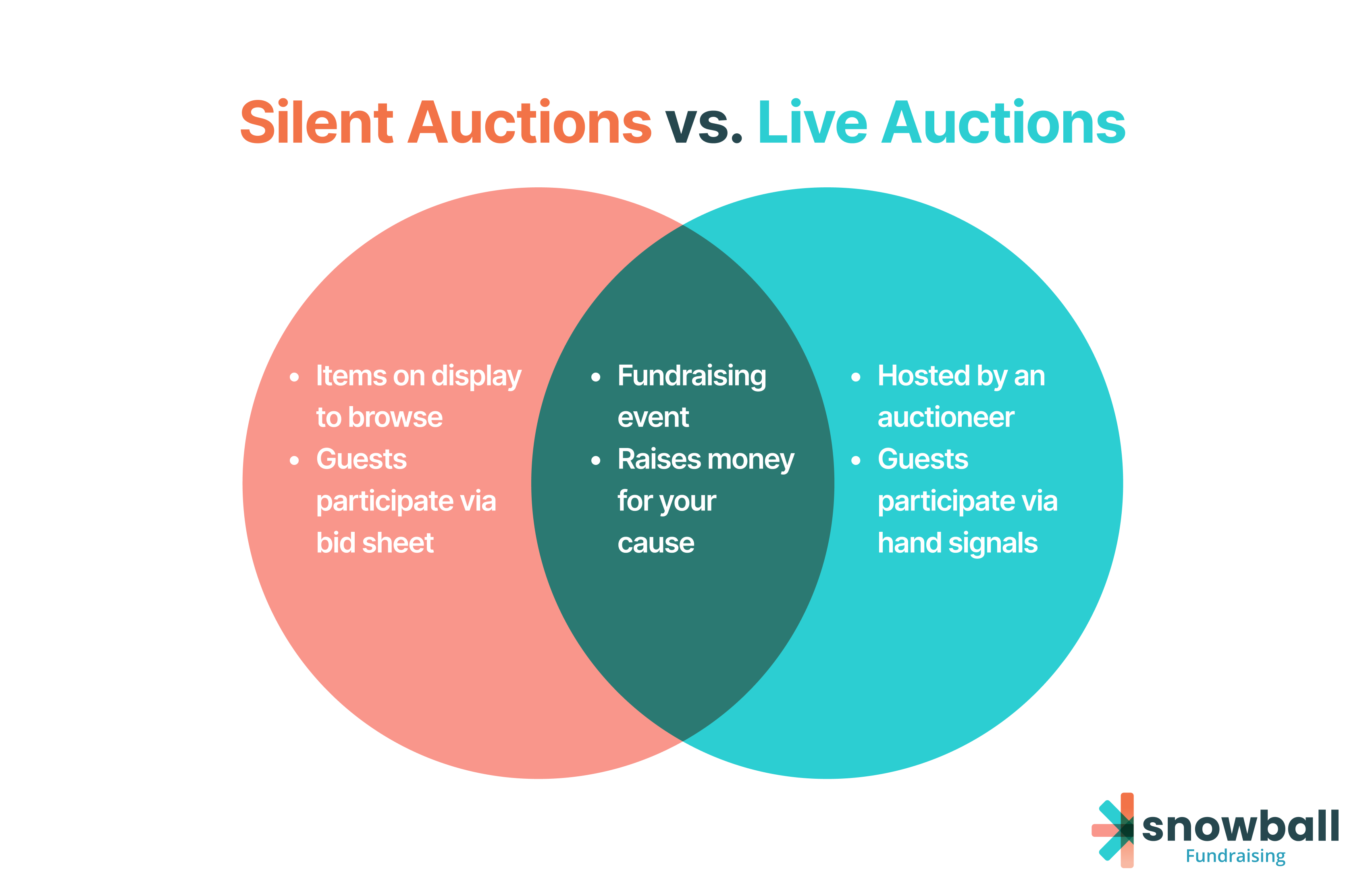
In silent auctions:
- Guests can browse items on display.
- Participants place their bids via bid sheets.
Live auctions, in contrast:
- Are hosted by an auctioneer.
- Use hand signals for the bidding process while the auctioneer is talking.
Whereas guests have to attend a live auction in order to participate, silent auctions can be hybrid by accepting bids on a virtual platform. All you need is an event management tool that offers mobile bidding features. Then, more supporters can participate and donate to your cause!

Why Host This Type of Auction?
Silent auctions are particularly advantageous for the following reasons:
- They’re inexpensive. All you’ll need are the auction items, your auction platform, and bidders! You can easily set up enticing item displays at low costs and raise even more revenue by selling concessions.
- Bidding is kept private. More people will be likely to bid on items when they don’t have to engage in a bidding war in front of a large crowd. Bidders can privately compete for items and wait to find out if they’ve won.
- Supporters are more engaged. Without the presence of an auctioneer and simultaneous bidding, guests can mingle with each other and your nonprofit’s leaders or volunteers. This creates more opportunities for you to communicate your cause, connect with potential donors, and cultivate a healthy community of supporters.
Plus, silent auctions allow for mobile bidding, which can help your nonprofit reach a larger audience.
How Do They Work?
Before you can start planning your event, it’s a good idea to first understand the way it should function.
For this event, items are typically set up throughout a physical space with a sheet of paper, called a bid sheet, at each one. When participants find an item they’d like, they simply write their bid amount (in dollars) with their anonymous bidding number that they receive upon registration or check-in.
Nonprofit auction software provides a streamlined, tech-based alternative in which attendees can efficiently bid from their phones instead. Users can then be notified when they’ve been outbid and decide to raise their bid to stay in the game.
As participants explore your available items, individuals continually one-up each other by placing a slightly higher bid than the person before them. After the event, the individual with the highest bid “wins” the item in question, pays the agreed-upon amount, and is gifted the item. Proceeds from bids are then collected and go toward funding your mission.
How to Run a Silent Auction
Now that you know the basics of silent auctions, you’re ready to walk through the steps involved in planning and hosting the event itself.
Like any fundraiser, extensive preparation is crucial for ensuring a successful event. An auction may require more planning than most events, so here are three key stages to keep in mind:
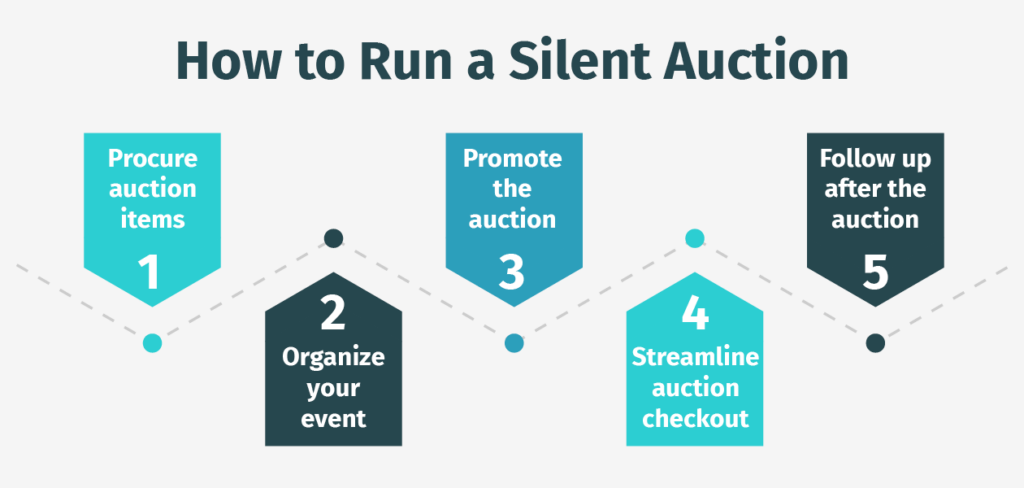
1. Procure auction items
Donors cherish the opportunity to support your cause while also receiving a tangible item in return—it’s a win-win!
Your auction items are the star of the show, so it’s crucial to get started with this step as early as possible—typically, 3-6 months before your planned event is a reasonable time frame. Build a procurement team of five or six dedicated individuals—preferably a combination of nonprofit staff and volunteers—who are willing to solicit auction items from family, friends, community members, and local businesses.
Your revenue collection can be directly impacted by offering high-demand auction items, such as:
- Special experiences from local favorite restaurants. Consider which eateries in your community are fan favorites and secure a gift your participants are sure to want. Think about prizes like gift cards, private dinner parties, or tasting events with the head chef.
- Valuable virtual experiences. Plan a virtual cooking or cocktail-making class with a chef. You might even be able to have a virtual meet-and-greet with a celebrity!
- Exclusive items. What items are of high value to your participants? Consider items such as expensive wine, an autographed jersey, or perhaps a piece of high-end jewelry.
Consider what establishments in your area could contribute an item or experience. When you form partnerships with local businesses, you can solicit gifts for free and low costs, ensuring maximum revenue for supporting your mission.
Remember to choose items that appeal to your specific audience. For example, a local school will have a much different supporter base than a large-scale nonprofit, and auction items should be adjusted as such. Include items of various price ranges so that all bidders can opt for something they’d reasonably be able to afford.
2. Organize your event
Once you’ve procured the perfect items, it’s time to pull together the rest of the event’s details. This may include:
- Volunteers. Plan out the number of volunteers you’ll need and what their roles will be at the event. Then, plan a recruitment and training process to start creating your dream team!
- Venue setup. From table arrangements to item displays, organize your venue to facilitate a seamless event flow. Put yourself in your guests’ shoes and imagine what their experience should be when attending the event.
- Registration. Plan how participants should sign up and check in to your fundraiser. If you use auction software that offers online registration and ticketing, this process will run smoothly.
Just because you need to plan the event’s logistics doesn’t mean this stage has to be boring. In fact, this is your opportunity to infuse your event with creativity! Brainstorm ways your volunteers can add some excitement to the fundraiser or unique venue decorations to wow your guests.
3. Promote the auction
Your promotion strategy is one of the most important elements of your silent auction prep. After all, your dedicated supporters must first be made aware of your event plans beforehand to attend and participate. Here are a few easy marketing channels your nonprofit can use to get the word out about your auction:

- Your website. Use your website as the main source of information for your auction, including event details and a registration form on a dedicated landing page for the event. Your website might already receive a lot of traffic, but you can also use marketing resources like Google’s Ad Grant program to promote the page and draw more attention to your site. Also, keep search engine optimization (SEO) best practices in mind to make your website even more visible.
- Email. Email is a favorite for donor communications. For one, you can easily invite thousands of individuals in just a few clicks. Plus, email marketing software allows you to personalize invitations and address each donor by name without sending a separate invite to each. Once a supporter receives your invitation, they can quickly navigate to your registration page with a bright and eye-catching call to action.
- Mail. Everyone loves getting mail, especially when it’s not a bill. That’s why sending invitations via direct mail can be an effective way to inform supporters of your upcoming event and boost excitement from the beginning. Plus, your physical invite can serve as a powerful reminder for individuals who might hang it on their refrigerator or leave it around the house.
- Social media. This is a great way to spread the word far and wide, including potential guests you may not have on your email or mailing lists. Share posts including the date, time, and if applicable, a location and registration link for your auction. Encourage current supporters to interact with and share your posts with their own social media networks, effectively expanding your reach and introducing you to new avenues of support.
While your outreach strategies will likely be adjusted to your particular supporter base, it’s a good practice to implement multiple of these key suggestions. In fact, studies show that 72% of consumers would rather connect with brands through a multichannel approach.
4. Streamline auction checkout
Imagine this: It’s the end of the night and bidders have enjoyed a long evening of mingling with friends and bidding on enticing items. Now, it’s time to pay for and collect the items they’ve won. They’re eager to receive the item they competed for, but as they approach the check-out table near your venue’s exit, they see a long line of guests also waiting to receive their items and feel discouraged from attending future auctions.
At the end of a successful event, finish strong with a streamlined checkout process! With mobile bidding software, participants can input their payment information and pay directly from their phones, eliminating the need for a physical checkout table. You can even send automated email receipts so bidders receive confirmation that you received their payment.
5. Follow up after the auction
Post-auction operations play a considerable role in whether your attendees return for future events. Be sure to have a carefully organized, streamlined checkout process for your winners so that they can pay, receive their items, and head out without complication.
A few days later, be sure to thank all of your guests for participating and ask them to fill out a quick survey. This way you can get a feel for what your attendees really thought about your event, including what can be improved for next time.
Each of these is a crucial element in a successful auction and something you don’t want to leave to the last minute—or to chance! When participants and attendees can tell you put a lot of time, effort, and thought into pulling off the event, they’re more likely to get involved.
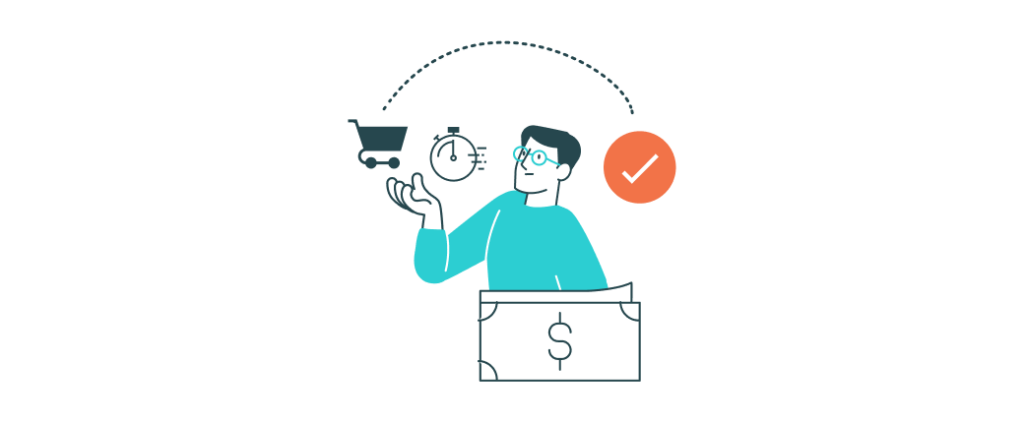
Best Practices for Silent Auctions
Even if this is your first time planning a silent auction, the good news is that thousands of organizations before you have helped pave the way for a successful event—and can provide some best practices to ensure yours gets off without a hitch. Let’s walk through some tried-and-true tips to get you started.
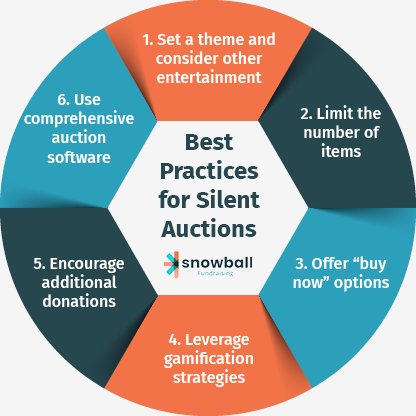
1. Set a theme and consider other entertainment
While not every auction has to be a themed one, choosing and sticking with a particular theme is a great way to boost excitement for your event. Depending on when your auction will fall in the calendar year, you may consider planning an event around a major holiday such as:
- Valentine’s Day
- Halloween
- Christmas
Another creative idea would be aligning your silent auction theme with your organization’s mission. For example, if your nonprofit supports wildlife conservation, you could decorate the venue like a rainforest with related items available for bidding.
2. Limit the number of items
It may be tempting to collect and auction off as many items as you can. After all, more items to bid on means more money, right?
In reality, an overabundance of auction items can spread out bids too thinly and reduce the competition for top items that end up driving prices through the roof. Select a few big-ticket auction items that will be in high demand (such as an automobile or vacation package), supplemented by some smaller and mid-sized items like gift cards, local experiences, and artwork.
3. Offer “buy now” options
Bidding is a great way to drive prices up on valuable and high-demand items at your auction. However, some attendees prefer the convenience and certainty of “buy now” options.
In addition to your top auction items, provide some items available for immediate purchase. Be sure to set the price high enough to make a decent profit—a good practice is to set the price at twice the item’s retail value.
4. Leverage gamification strategies
In the same way that competitive bidding can spur donations, gamification techniques can boost your auction’s fundraising capabilities. Popular methods include:
- Displaying a fundraising thermometer
- Creating leaderboards
- Giving away prizes
A great way to implement such a strategy into your silent auction planning is by alerting participants when they’ve been outbid. Provide a countdown clock to motivate users to make their next move before they lose the item.
5. Encourage additional donations
The vast majority of funds raised through your silent auction will likely come from auction item sales. However, that doesn’t mean it has to be your only source of revenue!
Consider asking for additional donations across multiple points of contact, including pre-registration donation pages and day-of opportunities to give. This way, you can provide an easy way for dedicated supporters to go above and beyond for your organization and bring in more funding for your mission.
6. Use comprehensive auction software
The right software makes any fundraiser run smoothly. Your silent auction is no different! Effective silent auction software allows you to:
- Accept additional donations
- Provide mobile bidding options
- Streamline the checkout process
- Add photos and descriptions of items
- Send an email and/or text notifications
- Compile all your auction data in one spot
- Implement a countdown when the auction closes
Auction software comes in handy whether you’re running an entirely virtual experience, a hybrid event, or a traditional in-person auction. Be sure to research your options and find the right auction software for your event and your cause.
Top Silent Auction Software
Your auction software can take your event to the next level, so be sure to find the ideal option for your nonprofit. After all, this tool will streamline every step of the auction process—including registration, bidding, and payment.
At Snowball, we understand that the auction software you choose should help things run smoothly, which is why our auction software offers:
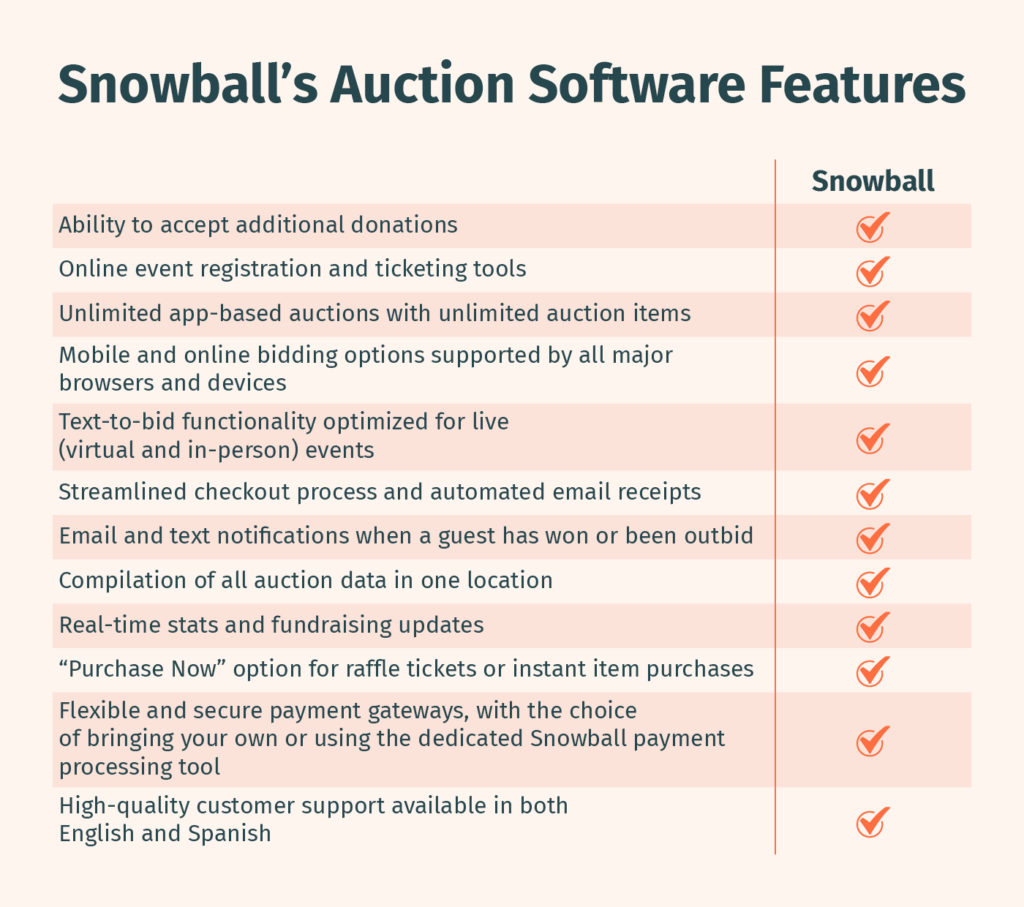
- Ability to accept additional donations via your Snowball account
- Online event registration and ticketing tools
- Unlimited app-based auctions with unlimited auction items
- Mobile and online bidding options offering contactless participation, supported by all major browsers and devices for increased accessibility
- Text-to-bid functionality optimized for live (virtual and in-person) events
- Streamlined checkout process and automated email receipts
- Email and text notifications when a guest has won or been outbid
- Compilation of all auction data in one location
- Real-time stats and fundraising updates
- “Purchase Now” option for raffle tickets or instant item purchases
- Flexible and secure payment gateways, with the choice of bringing your own or using the dedicated Snowball payment processing tool
- High-quality customer support available in both English and Spanish
…and so much more. Our powerful suite of fundraising tools balances your nonprofit’s need for affordable yet robust fundraising software—we offer the greatest valued auction tools in the market.
Still not convinced? Here’s how our platform helped Friends of Franklin Parks raise more:
- $41,017—a record-setting amount—raised in auction revenue at the first event using Snowball’s platform
- 64% increase in auction revenue
- 437 bids generated
$77,199 revenue raised on the Snowball Fundraising Platform in 6 months
Use our platform to streamline your silent auctions and any other fundraising events you plan after your auction concludes! From text-to-give to pledge campaigns, our software can manage it all.

